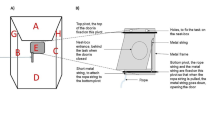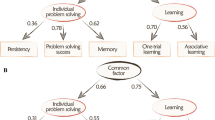Abstract
In mammals, including humans, the most consistent cognitive sex difference appears to be a male advantage in spatial ability. Usually, some sex-correlated selective advantage is inferred to explain this, for example, the need for males to navigate over large territories. In birds, sex differences in learning abilities are rare. Here, we show that females of a common European songbird, the great tit, do clearly better than males in an observational memorization task. We allowed caged great tits to observe food-caching marsh tits in an indoor aviary. One hour later, the great tits were released to search for the cached food. Females consistently performed better than males in this task. The results are remarkable for several reasons: (i) a sex difference in a cognitive ability of such a magnitude is unusual; (ii) most sex differences in spatial ability that have been reported so far concerns a male advantage; and perhaps most remarkably, (iii) female great tits were as successful in relocating the cached food as the hoarding marsh tits themselves. We hypothesize that female great tits are better at this than males because they are subordinate foragers. Males have prior access to food in nature and can easily displace females. Females will then benefit from a special ability to memorize caching positions that makes it possible for them to return and retrieve the food later when males are not around.


Similar content being viewed by others
References
Bednekoff PA, Balda RP (1996) Observational spatial memory in Clark’s nutcrackers and Mexican jays. Anim Behav 52:833–839
Brodin A, Urhan AU (2013) An evaluation of memory accuracy in food hoarding marsh tits Poecile palustris—how accurate are they compared to humans? Behav Process 97:25–32
Brodin A, Urhan AU (2014) Interspecific observational memory in a non-caching Parus species, the great tit Parus major. Behav Ecol Sociobiol 68:649–656
Cole EF, Cram DL, Quinn JL (2011) Individual variation in spontaneous problem-solving performance among wild great tits. Anim Behav 81:491–498
Cramp S, Perrins CM (eds) (1993) Parus major Great tit. Handbook of the birds of Europe the Middle East and North Africa: The birds of the Western Palearctic. Oxford University Press, Oxford, pp 255–279
Dally JM, Clayton NS, Emery NJ (2006) The behaviour and evolution of cache protection and pilferage. Anim Behav 72:13–23
Dingemanse NJ, de Goede P (2004) The relation between dominance and exploratory behavior is context-dependent in wild great tits. Behav Ecol 15:1023–1030
Estók P, Zsebok S, Siemers BM (2010) Great tits search for, capture and eat hibernating bats. Biol Lett 6:59–62
Gibb J (1954) Feeding ecology of tits, with notes on treecreeper and goldcrest. Ibis 96:513–543
Gosler AG, Clement P (2007) Family Paridae (tits and chickadees). In: del Hoyo J, Elliot A, Christie DA (eds) Handbook of the birds of the world, vol.12. Picathartes to tits and chickadees. Lynx Edicions, Barcelona, pp 662–750
Grodzinski U, Clayton NS (2010) Problems faced by food-caching corvids and the evolution of cognitive solutions. Philos T Roy Soc B 365:977–987
Guigueno MF, Snow DA, MacDougall-Shackleton SA, Sherry DF (2014) Female cowbirds have more accurate spatial memory than males. Biol Lett 10:1–4
Heinrich B, Pepper JW (1998) Influence of competitors on caching behaviour in the common raven. Anim Behav 56:1083–1090
Hinde RA (1952) The behaviour of the great tit (Parus major) and some other related species. Behaviour Suppl 2:1–201
Jones CM, Healy SD (2006) Differences in cue use and spatial memory in men and women. Proc R Soc Lond B 273:2241–2247
Jones CM, Braithwaite VA, Healy SD (2003) The evolution of sex differences in spatial ability. Behav Neurosci 117:403–411
Krams I (1998) Dominance specific vigilance in the great tit. J Avian Biol 29:55–60
Krebs JR, MacRoberts MH, Cullen JM (1972) Flocking and feeding in the great tit Parus major—an experimental study. Ibis 114:507–530
Male LH, Smulders TV (2007) Memory for food caches: not just for retrieval. Behav Ecol 18:456–459
Moffat SD, Hampson E, Hatzipantelis M (1998) Navigation in a “virtual” maze: sex differences and correlation with psychometric measures of spatial ability in humans. Evol Hum Behav 19:73–87
Range F, Bugnyar T, Schögl C, Kotrschal K (2006) Individual and sex differences in learning abilities of ravens. Behav Process 73:100–106
Reboreda JC, Clayton NS, Kacelnik A (1996) Species and sex differences in hippocampus size between parasitic and non-parasitic cowbirds. Neuroreport 7:505–508
Sasvári L (1979) Observational learning in great, blue and marsh tits. Anim Behav 27:767–771
Sherry DF, Hampson E (1997) Evolution and the hormonal control of sexually-dimorphic spatial abilities in humans. Trends Cogn Sci 1:50–56
Sherry DF, Forbes MRL, Khurgel M, Ivy GO (1993) Females have a larger hippocampus than males in the brood-parasitic brown-headed cowbird. Proc Natl Acad Sci U S A 90:7839–7843
Ethical standards
This work was carried out under permit M-106-13 to AB from the Malmö-Lund regional ethical permit board in compliance with the Swedish and EU animal care legislation. The birds were captured under bird ringing license 582 to AB from the Swedish Museum of Natural History with a special permit to use playback recordings.
Author information
Authors and Affiliations
Corresponding author
Additional information
Communicated by N. Clayton
Rights and permissions
About this article
Cite this article
Brodin, A., Utku Urhan, A. Sex differences in learning ability in a common songbird, the great tit—females are better observational learners than males. Behav Ecol Sociobiol 69, 237–241 (2015). https://doi.org/10.1007/s00265-014-1836-2
Received:
Revised:
Accepted:
Published:
Issue Date:
DOI: https://doi.org/10.1007/s00265-014-1836-2




